Table of Contents
TogglePersian Geometric Patterns are a harmonious blend of art and mathematics. The art of Persian geometric patterns has captivated the world with its exquisite beauty and involved designs. Rooted in a rich cultural heritage that spans centuries, these patterns showcase the deep connection between art and mathematics. From mesmerizing tile work in mosques to delicate carpets and textiles, these geometric patterns reflect a harmonious blend of creativity, spirituality, and precise mathematical principles. In this article, we will explore the origins, symbolism, and techniques behind these captivating designs that continue to inspire awe and admiration.
Historical Origins of Persian geometric patterns
The historical origins of Persian geometric patterns can be found in the ancient Persian civilization, which flourished in present-day Iran. Rooted in a diverse cultural heritage and influenced by various civilizations that left their mark on the region, these intricate designs reflect a rich tapestry of artistic expression that has evolved over the centuries. This beautiful and rich art is presented to the world from Iran.
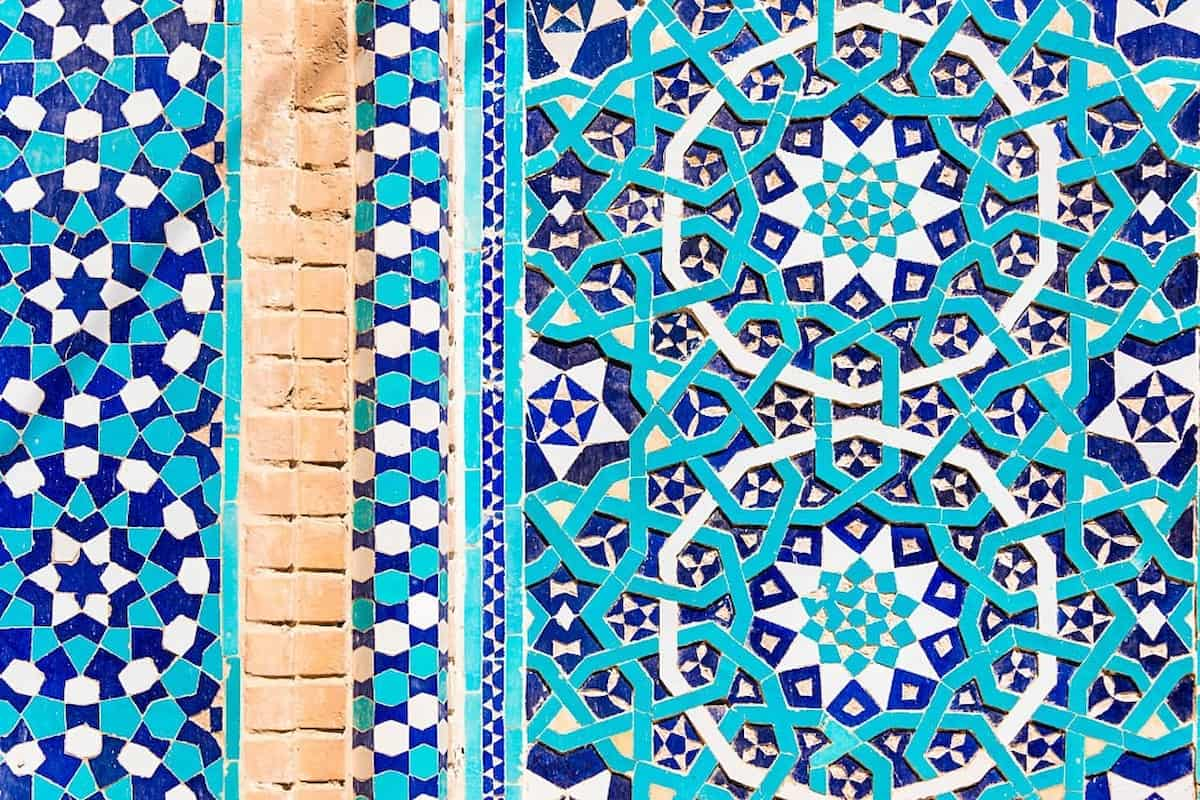
Pre-Islamic Influences
Before the rise of Islam, Persia was home to a succession of powerful empires, including the Achaemenid, Parthian, and Sassanian dynasties. These civilizations, known for their advancements in art, architecture, and craftsmanship, laid the foundation for the development of Persian geometric patterns.
One notable influence on Persian art was the ancient Mesopotamian civilization, particularly the Babylonian and Assyrian cultures. These civilizations employed geometric motifs in their architectural designs and decorative arts. Persian artisans adapted and incorporated these elements, infusing them with their own unique style.
Another influential source was Zoroastrianism, the dominant religion in pre-Islamic Persia. Zoroastrian symbolism, with its focus on duality, balance, and cosmic order, played a significant role in shaping Persian art. Geometric patterns became a way to express these philosophical and spiritual concepts, representing the harmony and balance between opposing forces.
Islamic Influences
With the advent of Islam in the 7th century, Persian art underwent a profound transformation. Islamic-era art, which prohibits the representation of living beings, emphasized non-representational geometric patterns as a means of artistic expression. This led to the flourishing of Persian geometric patterns, which became an integral part of Islamic-era art and architecture.
Read more: Islamic geometric patterns
The migration of Arab Muslims to Persia brought with it a fusion of cultural and artistic influences. Persian artisans embraced the principles of geometric art, including the use of geometric shapes, tessellation, and intricate patterns, while infusing them with their own artistic sensibilities.
The Seljuk and Timurid periods (11th to 15th centuries) marked a golden age for Persian art and architecture. The Seljuks, a Turkic dynasty, and the Timurids descended from the Mongol conqueror Timur, patronized the arts and contributed to the refinement and expansion of Persian geometric patterns. These periods saw the construction of grand mosques and palaces adorned with intricate tilework, featuring geometric motifs and floral islimi khataei (arabesque) designs.
Techniques and Materials
Persian artisans developed sophisticated techniques to create their geometric patterns. These techniques involved the precise measurement and arrangement of geometric shapes, such as squares, triangles, hexagons, and stars. Symmetry played a crucial role, both in terms of reflectional symmetry (mirroring) and rotational symmetry, which added depth and complexity to the designs.
Materials used in the creation of Persian geometric patterns varied depending on the medium. In architecture, intricately patterned tiles, often in vibrant colors, were used to decorate facades, domes, and interior spaces. Carpets, another iconic form of Persian artistry, showcased finely woven geometric motifs using a combination of natural dyes and luxurious materials such as silk and wool.
Legacy and Revival
Despite political, social, and cultural upheavals throughout history, the tradition of these geometric patterns has managed to endure. The knowledge and skills associated with creating these patterns have been passed down through generations of artisans and craftsmen, often within specialized guilds.
In recent years, there has been a renewed interest in Persian geometric patterns, both within Iran and internationally. Artisans and designers are exploring new ways to reinterpret and adapt these ancient designs to contemporary contexts. This revival ensures that the legacy of these patterns continues to inspire and captivate audiences worldwide.
Locations where you can find Persian geometric patterns
Girih star and polygon patterns with five and ten-fold rotational symmetry are often known as Persian geometric patterns. In the Timurid periods, we have the Blue Mosque, Jameh Mosque of Yazd, Jameh Mosque of Kerman, and the school of Khargerd in Khorasan. Brickwork in the Razi style like Malek Zuzan Mosque in Khorasan or Kharaqan Towers in Qazvin is also a famous historical monument in Iran in which these geometric patterns are used in them.
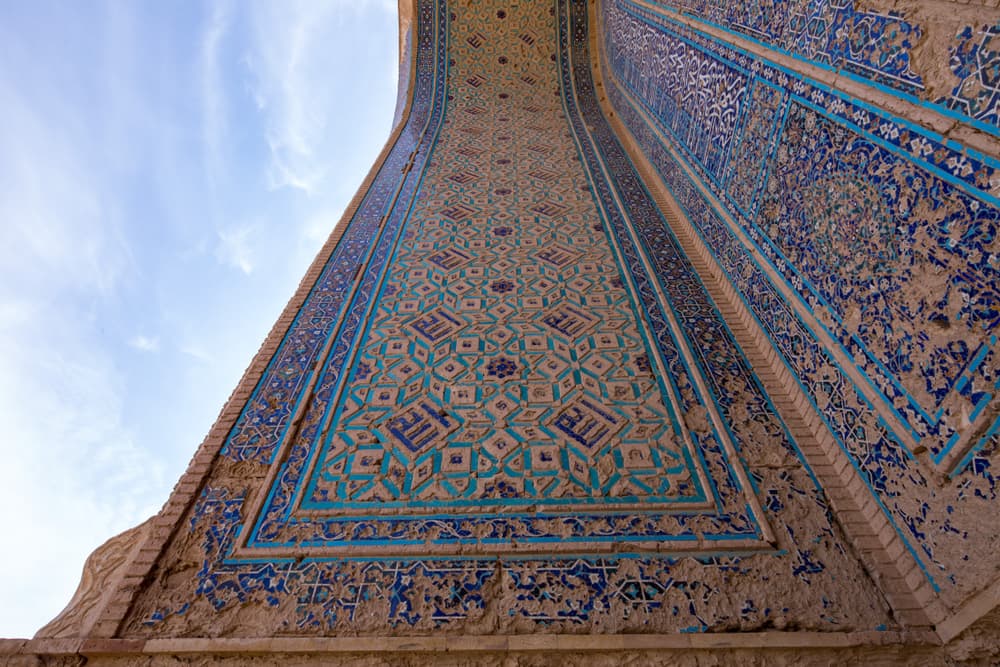
Symbolism and Spiritual Significance of Persian geometric patterns
Persian geometric patterns often carry deep symbolic meanings and spiritual significance. Islamic-era art, which influenced Persian designs, places emphasis on creating non-representational patterns to avoid the depiction of living beings. Geometric patterns became a way to express the infinite nature of the divine and evoke a sense of transcendence. The intricate repetition of shapes and motifs symbolizes the eternal and unbroken nature of the universe, while the interplay of symmetry and asymmetry represents the balance between order and chaos.
Persian geometric patterns are known for their involved designs and are often rich in symbolism and spiritual significance. These patterns can be found in various forms of Persian art and architecture, such as carpets, textiles, pottery, Brickwork, and even architecture.
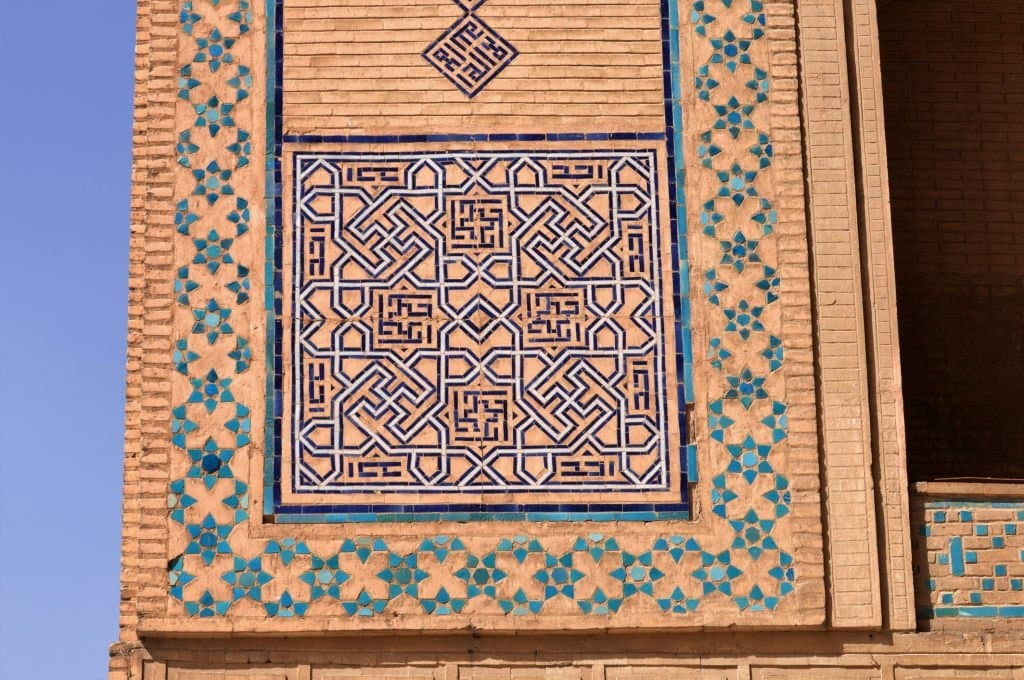
Here are some key aspects regarding the symbolism and spiritual significance of these patterns:
Unity and Harmony
Persian geometric patterns often represent the concept of unity and harmony within the universe. The repetitive nature of these patterns symbolizes the interconnectedness of all things and the harmony that exists in the natural world.
Balance and Order
These patterns are characterized by their symmetry and balance. The precise arrangements of shapes and motifs symbolize order and balance in the universe. This reflects the idea of cosmic equilibrium and the divine order that governs all aspects of life.
Infinite and Eternal
These patterns often feature repeating motifs that extend infinitely in all directions. This symbolizes the notion of eternity and the infinite nature of the universe. It represents the belief that the spiritual realm transcends the boundaries of time and space.
Symbolic Motifs
Many Persian geometric patterns incorporate specific motifs that hold symbolic meanings. For example, the “Paisley” or “Boteh” motif represents fertility and abundance. The “Star” motif symbolizes divine light and enlightenment, while the “Bird” symbolizes freedom and spirituality.
Protection and Defense
Some of these patterns, such as the “Guls” and “Medallions,” are believed to have protective and defensive properties. These patterns were commonly used in carpets and textiles to ward off evil spirits and bring good fortune to the viewer.
Spiritual Journey
These patterns can also represent the spiritual journey and transformation of the individual. The intricate patterns can be seen as a metaphor for the complex path toward enlightenment and spiritual growth.
In Persian culture, these geometric patterns are much more than just decorative elements. They serve as a visual language that communicates deep spiritual and symbolic meanings. Whether it is the balance and harmony of the designs or the representation of cosmic concepts, Persian geometric patterns continue to carry immense spiritual significance to this day.
Design Elements and Techniques of Persian geometric patterns
Persian geometric patterns are created using a range of design elements and techniques. The fundamental building blocks of these patterns are geometric shapes such as squares, triangles, hexagons, and stars. These shapes are carefully arranged and interconnected to form intricate compositions. The repetition of these elements creates a sense of rhythm and harmony.
One of the most distinctive features of these geometric patterns is the concept of tessellation, which involves covering a surface with a single repeated shape without any gaps or overlaps. This technique allows for seamless integration and infinite expansion of the patterns. Another notable technique is the use of symmetry, both in terms of reflectional symmetry (mirroring) and rotational symmetry, which adds a captivating visual complexity to the designs.
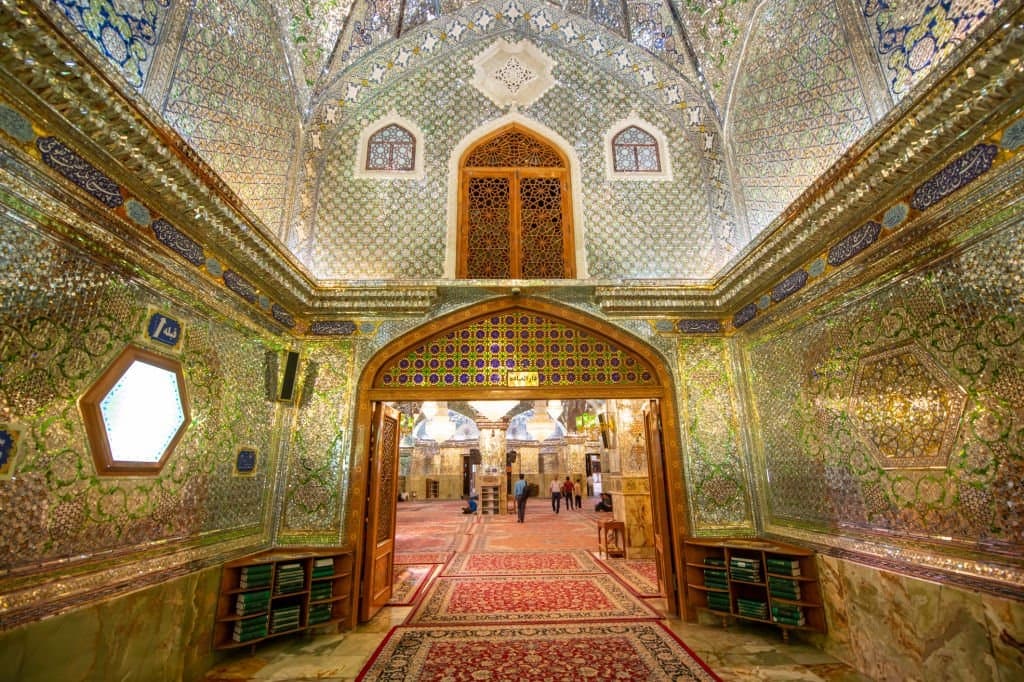
Here are some key design elements and techniques commonly found in Persian geometric patterns:
Symmetry
Symmetry plays a crucial role in these geometric patterns. The patterns are often based on a central axis, with motifs and shapes mirrored on either side. This creates a sense of balance and harmony within the design.
Repetition
Persian geometric patterns rely heavily on repetition. Motifs, shapes, and colors are repeated throughout the pattern, creating a sense of rhythm and cohesion. The repetition of these elements adds depth and complexity to the overall composition.
Read more: How to draw Islamic geometric patterns
Geometric Shapes
These geometric patterns prominently feature various geometric shapes, such as triangles, squares, hexagons, and stars. These shapes are meticulously arranged to create intricate patterns and tessellations. Each shape has its own symbolic significance and contributes to the overall visual appeal of the design.
Interlacing
Interlacing is a technique commonly used in these geometric patterns. It involves weaving and intertwining lines and shapes to create a complex and interconnected design. This technique adds depth and intricacy to the pattern, making it visually captivating.
Color palette
Persian geometric patterns are often characterized by a rich and vibrant color palette. They incorporate a wide range of colors, including blues, reds, greens, and gold. These colors are carefully chosen to create contrast and enhance the visual impact of the pattern.
Gridding and Scaling
These geometric patterns are typically based on a grid or a mathematical system. This grid helps in creating precise and symmetrical designs. Additionally, the scaling of motifs and shapes allows for the repetition of patterns on different scales, adding depth and complexity to the overall composition.
Stylized Nature
Persian geometric patterns often incorporate elements inspired by nature, such as flowers, leaves, and animals. However, these elements are stylized and abstracted to fit within the geometric framework of the pattern. This blending of natural and geometric forms creates a unique visual language.
Skillful Craftsmanship
These geometric patterns are the result of meticulous craftsmanship and attention to detail. These patterns are often handcrafted by skilled artisans who have honed their craft over generations. The intricate details and precision in execution contribute to the overall quality and beauty of the design.
Persian geometric patterns are a testament to the ingenuity and creativity of Persian artisans. The combination of symmetry, repetition, geometric shapes, interlacing, and skilled craftsmanship results in breathtaking designs that continue to captivate and inspire people around the world.
Materials and Artistic Expressions of Persian geometric patterns
Persian geometric patterns are not limited to a particular medium. They can be found adorning a wide range of artistic expressions, including architecture, ceramics, metalwork, textiles, and carpets. Islamic-era architecture, in particular, showcases elaborate geometric patterns in its intricate tile work, creating stunning visual displays in mosques and palaces. Persian carpets, renowned for their craftsmanship and artistry, feature geometric motifs woven with exceptional precision, often using vibrant colors and intricate detailing.
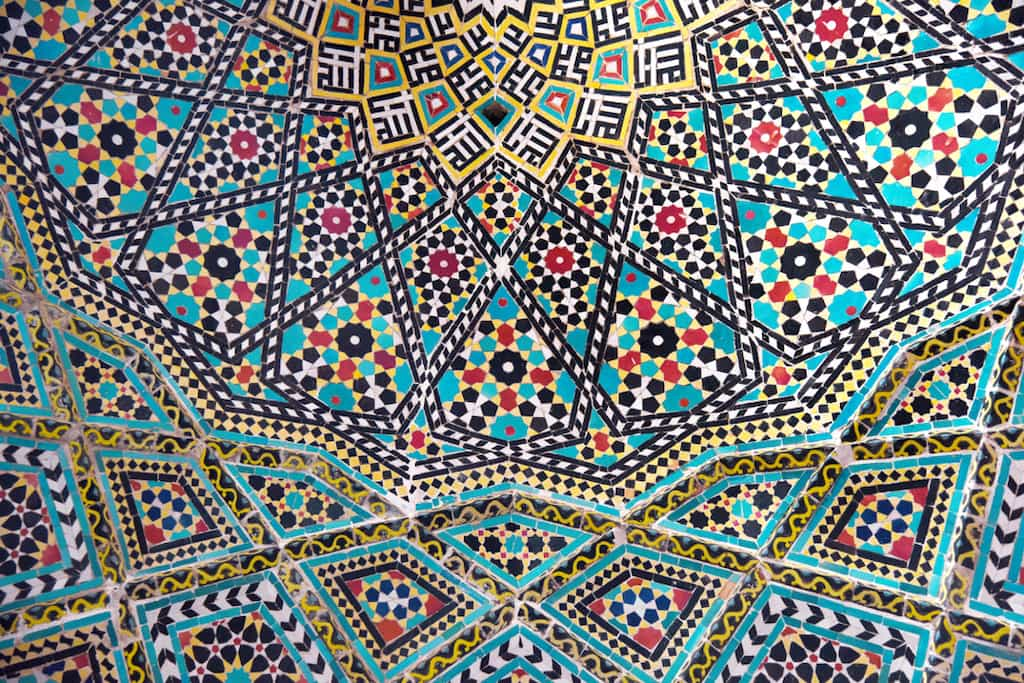
Some key materials and artistic expressions commonly used in Persian geometric patterns are:
Natural Materials
Persian geometric patterns are often created using natural materials such as silk, wool, cotton, and plant-based dyes. The quality of the materials used has a significant impact on the final product. For instance, silk is often used for finer details due to its exceptional ability to create intricate patterns.
Carpets and Textiles
Persian carpets and textiles are perhaps the most well-known forms of Persian art featuring geometric patterns. These are usually created using a loom, with the weaver carefully following a pre-drawn design. The carpets and textiles can take months or even years to complete, depending on the level of intricacy and size of the project.
Tiles
Persian tiles often feature geometric patterns as well. The tiles are fired to create a hard and durable surface, making them ideal for use in architectural settings, such as mosques, palaces, and public buildings. These tiles often feature tessellated geometric designs, created by carefully arranging and interlocking different shapes.
Calligraphy
Calligraphy is another artistic expression commonly found in Persian art, often alongside geometric patterns. These calligraphic elements serve to complement and contrast with the geometric designs while conveying a message or conveying the beauty of the Persian and Arabic script.
Illumination
Persian geometric patterns can also be found in illuminated manuscripts. The patterns are often used as decorative borders or as part of intricate designs within the text blocks. These manuscripts are meticulously handcrafted and decorated, featuring rich colors and intricate details.
Architectural Elements
Finally, Persian geometric patterns can be found in various architectural elements, such as domes, arches, and window grills. The geometric motifs are often combined with other artistic expressions, such as calligraphy and figurative elements, to create a stunning aesthetic.
Read more: Online Islamic art course
Preserving the Tradition of Persian geometric patterns
Despite its ancient origins, the tradition of Persian geometric patterns continues to thrive today. Artisans and craftsmen, often working within the confines of specialized guilds, diligently pass on their skills and knowledge from one generation to the next. The patterns themselves are not merely reproduced but are adapted and evolved to suit contemporary tastes, ensuring that this vibrant art form remains relevant and accessible to new audiences.
The tradition of Persian geometric patterns has a rich history and cultural significance in Persian art and architecture. Preserving this tradition is important to maintain the cultural heritage and promote a sense of pride and identity.
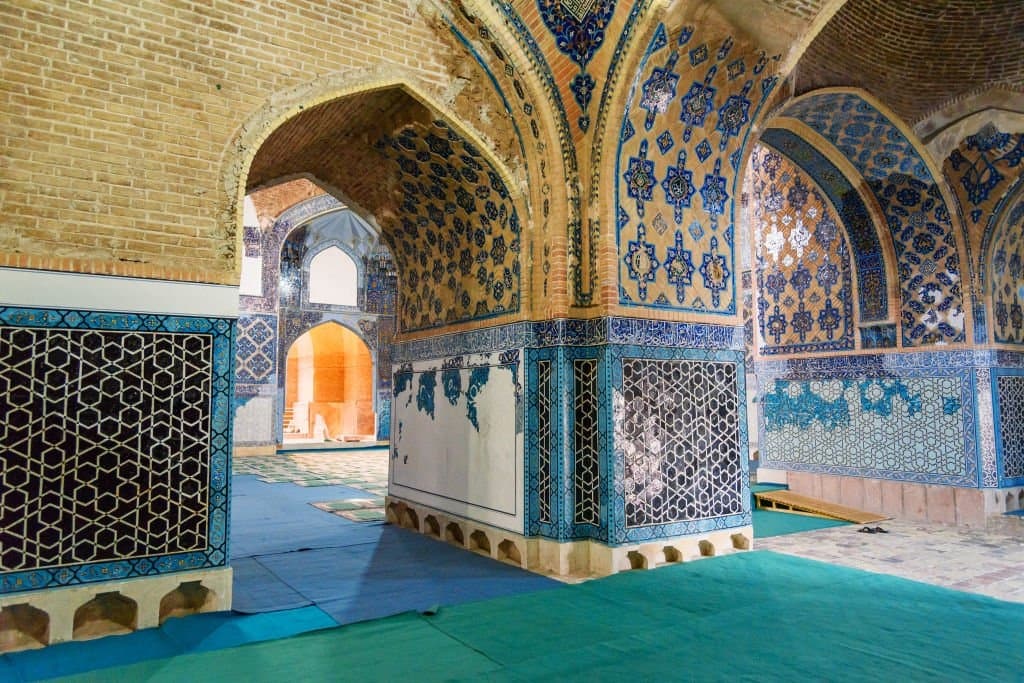
The tradition of Persian geometric patterns is being preserved through various methods:
Apprenticeships and Training
The tradition of Persian geometric patterns is passed down through apprenticeships and on-the-job training. Skilled artisans who have years of experience in creating these patterns mentor the next generation of artists and craftsmen. This hands-on training ensures that the techniques and skills are passed down and not lost to time.
Educational Programs
There are many educational programs in Iran and other countries that offer training in these geometric patterns. These programs teach the history, culture, and techniques behind the tradition, providing an avenue for students to learn the craft.
Workshops and Conferences
Regular workshops and conferences are held around the world, bringing together experts, artists, and enthusiasts to share knowledge and promote the tradition. These events offer an opportunity for artists and craftsmen to learn new techniques, exchange ideas, and build networks.
Technology and Innovation
There is increasing use of technology and innovation in the creation of Persian geometric patterns. Computer-aided design (CAD) software and laser-cutting machines are being used to create intricate designs that were once crafted by hand. This has helped to increase the efficiency and precision of the process while still maintaining the traditional aesthetic.
Support and Investment
The preservation of any cultural tradition requires support and investment. Governments, cultural organizations, and institutions can play a vital role in protecting and promoting the tradition of Persian geometric patterns. This can include funding for educational programs, workshops, and exhibitions, as well as policies that protect and foster traditional arts and crafts.
The tradition of these geometric patterns is an important aspect of Persian culture and history. Preserving this tradition requires concerted efforts by individuals, organizations, and governments around the world. By promoting apprenticeships and training, educational programs, workshops and conferences, technology and innovation, and support and investment, we can ensure that this rich tradition is passed down for generations to come.
FAQ about Persian geometric patterns
What are the historical origins of Persian geometric patterns?
The historical origins of Persian geometric patterns can be found in the ancient Persian civilization, which flourished in present-day Iran.
What is Symbolism and Spiritual Significance of Persian geometric patterns?
Geometric patterns became a way to express the infinite nature of the divine and evoke a sense of transcendence. The intricate repetition of shapes and motifs symbolizes the eternal and unbroken nature of the universe, while the interplay of symmetry and asymmetry represents the balance between order and chaos.
Conclusion
Persian geometric patterns embody the harmony between art and mathematics, offering a captivating visual representation of divine order and balance. Their intricate designs and symbolic meanings showcase the profound creativity and skill of Persian artisans. From the sacred spaces of mosques to the intricate carpets adorning homes around the world, these geometric patterns continue to inspire and captivate people with their timeless beauty and mesmerizing complexity.
